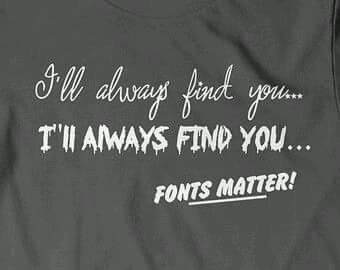Latest modern science | Link roundup for October 2015 - Si Bejo Science
link roundupA feature in The Atlantic asks a big question: Can posters still change the world? I�m unsure posters have ever changed the world, but no matter. Still a great article on the power of the poster format. Hat tip to Siobhan O�Dwyer.
The latest demonstration of how fonts affect interpretation...
Hat tip to Jim Ducharme and Danielle Lee.
I am an advocate of one space after a period. However, I appreciate this spirited defense of wider spacing after a period. In particular, the historical aspect of this blog post is well worth reading.
Make it all the way to the post-script if you can. I still say the single space is the modern standard (this post has the single space winning out around the 1940s), and you shouldn�t put put spaces after a period. Hat tip to Robert J. Sawyer, from his Facebook page.
Above you see a nice critique and makeover of a poster. Not a scientific poster, but still. Take a few minutes to let John McWade walk you through the process in a nice video.
The British Library adds over a million public domain images to Flickr.
The title of this article � Should you ever use a pie chart? � is a bit misleading. It includes a lot of history as well as best practices.
Hat tip to Justin Kiggins, if I remember right.
This month is the huge Neuroscience conference, possibly home to more academic posters than anything else on the planet. Don�t believe me? Check this panorama from Dwayne Godwin:
Before the meeting, people sent tips! From Lauren Drogos:
Andrew Pruszynski wrote:
I appreciate the sentiment, but I would replace �only� with �main.� I find seeing talks and posters useful. I find catching up with people I know useful.
And from Drugmonkey:
Though I don�t necessarily think you should put this on your poster...
From the meeting:
Peer review: shit just got real. (From Dr. Jenn)
And there is the inevitable aftermath of deciding how to use posters after the session is done. Tal Yarkoni has decided they are a fine place to rest one�s weary bones.
A critique of common scientific presentations: �Your protein acronyms and figures look nothing more than ambiguous letters and Pac-Man shapes to us.�
The latest demonstration of how fonts affect interpretation...
Hat tip to Jim Ducharme and Danielle Lee.
I am an advocate of one space after a period. However, I appreciate this spirited defense of wider spacing after a period. In particular, the historical aspect of this blog post is well worth reading.
If the (early editions) Chicago Manual thought it was okay to use large spaces after periods, and it had been common practice among the typographers who invented these typefaces, can we seriously claim that the only right method to set them is with a single space after a period? I CANNOT BELIEVE THE GALL OF MODERN TYPOGRAPHERS, ARGUING THAT THE PRACTICE OF THOSE WHO CREATED THEIR FONTS IS ABSOLUTELY, UNEQUIVOCALLY �WRONG.�
Make it all the way to the post-script if you can. I still say the single space is the modern standard (this post has the single space winning out around the 1940s), and you shouldn�t put put spaces after a period. Hat tip to Robert J. Sawyer, from his Facebook page.
Above you see a nice critique and makeover of a poster. Not a scientific poster, but still. Take a few minutes to let John McWade walk you through the process in a nice video.
The British Library adds over a million public domain images to Flickr.
The title of this article � Should you ever use a pie chart? � is a bit misleading. It includes a lot of history as well as best practices.
Hat tip to Justin Kiggins, if I remember right.
This month is the huge Neuroscience conference, possibly home to more academic posters than anything else on the planet. Don�t believe me? Check this panorama from Dwayne Godwin:
Before the meeting, people sent tips! From Lauren Drogos:
Let people pause and read before trying to engage at your poster, some of us are shy and need a moment to muster.
Andrew Pruszynski wrote:
Meeting new people is the only reason to go to SFN. The posters/talks are just pretext.
I appreciate the sentiment, but I would replace �only� with �main.� I find seeing talks and posters useful. I find catching up with people I know useful.
And from Drugmonkey:
Think of your poster design as a massive troll. The point is to engender conversation!!!
Though I don�t necessarily think you should put this on your poster...
From the meeting:
Peer review: shit just got real. (From Dr. Jenn)
And there is the inevitable aftermath of deciding how to use posters after the session is done. Tal Yarkoni has decided they are a fine place to rest one�s weary bones.
A critique of common scientific presentations: �Your protein acronyms and figures look nothing more than ambiguous letters and Pac-Man shapes to us.�
























